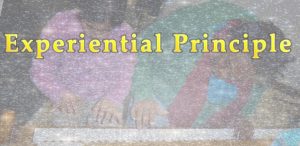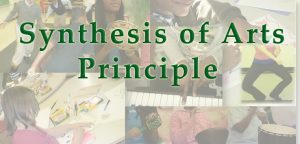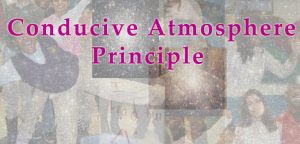IAM Pedagogy and Principles
The Integrated Arts Pedagogy and Philosophy (dissertation) claims and argues in practical and theoretical terms that effective, enjoyable, and memorable education can be achieved through an alternate pedagogy that is experience-based, well-integrated, conducive, and student-centered.
Dr. Soyfer’s doctoral research focused on IAM pedagogy and on its practical application to beginners’ education in music, dance, visual arts, and combinations thereof, leading towards accelerated development and emergent interconnections between these art forms within each student.
It was found through this research that IAM pedagogy can be successfully applied by adopting three guiding pedagogical and practical principles:
Experiential Principle: The experiential principle involves immediate student immersion into active and physical-based participation in a given subject area at a manageable level in group and goal oriented settings. Direct personal engagement in new experiences may activate or spark development in areas of the student’s brain, motor skill system, and memory system that would otherwise lay dormant to a certain degree.
Synthesis of Arts Principle: The synthesis of arts principle involves integration of experiences in related subject areas leading to personalized connections and relations between those subject areas and associated experiences, concepts, senses, skills, and knowledge schemas (Sweller et al. 1998). Students develop different skills depending on which subject area they study. However, when combined in close proximity or simultaneously, related developments can become inter-connected, associated with each other as a joined memory, and synthesized within a student through integrated experiences.In IAM programs, for example, this principle was facilitated through combining first-hand experiences of music, dance, and painting (i.e., in close proximity or simultaneously), in order to facilitate multi-sensory and multi-artistic encoding. This process is aimed at broadening creative self-expression and accelerating development through emergent interconnections relating these art forms within each participant.
Conducive Atmosphere Principle: The conducive atmosphere principle involves a positive and accepting learning environment with targeted, high-quality skill training. This principle requires a nurturing and non-judgmental pedagogical attitude, combined with techniques aimed at high-quality[1] education with stimulating and appropriately challenging learning goals, which are meant to help students achieve intrinsic motivation and active enthusiasm for learning. The goals are aimed at specific achievements as a group and individually. Such an environment can heighten participants’ self-esteem through achievement of specific learning objectives in a given subject area. Ways of achieving these objectives are chosen in collaboration with students and motivated through their own intrinsically desired and active learning intentions.In IAM programs, for example, groups of [music and arts] beginners were willingly transformed into performing ensembles, with first-hand experience of public presentation, performance etiquette, prepared repertoire, and art exhibition. This principle facilitates a self-view shift in participants, namely, from outsiders to practitioners of a given art.This principle also facilitates nurturing all facets of the student by invigorating, nourishing, or calming the body and/or mind if and when needed. This is achieved in IAM programs through activities such as sharing circles and lively physical warm-ups.
[1] The term “high-quality” refers in this work to students’ achievement of the specific goals associated with excellence within a given program.
Application of Key IAM Principles
Subject-independent IAM pedagogical procedures for applying these key principles involve:
 (1) engaging students in active experiences, i.e., physical experiences, in goal-oriented group and individual settings, with disciplined and creative exercises;
(1) engaging students in active experiences, i.e., physical experiences, in goal-oriented group and individual settings, with disciplined and creative exercises;
 (2) synthesizing more than one type of experience into the same knowledge schema, i.e., combining subjects in one class and in one activity, in order to facilitate multi-sensory and integrated encoding and subsequent recall; and
(2) synthesizing more than one type of experience into the same knowledge schema, i.e., combining subjects in one class and in one activity, in order to facilitate multi-sensory and integrated encoding and subsequent recall; and
 (3) sustaining optimal learning states in students during these experiences, i.e., by eliciting positive emotions, by using methods and materials that are both manageable and stimulating, and by providing a personally relevant learning environment that nurtures “physiological coherence” in students (Arguelles, McCraty, and Rees 2003, 15).
(3) sustaining optimal learning states in students during these experiences, i.e., by eliciting positive emotions, by using methods and materials that are both manageable and stimulating, and by providing a personally relevant learning environment that nurtures “physiological coherence” in students (Arguelles, McCraty, and Rees 2003, 15).
Continue reading about the 3 principles by clicking here: Experiential IAM Principle, Synthesis of Arts IAM Principle, Conducive Atmosphere IAM Principle.
Bibliography:
Arguelles, Lourdes, Rollin McCraty and Robert A. Rees. 2003. “The Heart in Holistic Education.” In Encounter: Education for Meaning and Social Justice, vol. 16, no. 3, pp. 13-21. http://www.heartmath.org/templates/ihm/downloads/pdf/research/publications/heart-in-education.pdf (accessed April 11, 2014).
Soyfer, Nina. 2016. “Integrated Arts Pedagogy and Philosophy.” Canada: York University. http://yorkspace.library.yorku.ca/xmlui/handle/10315/32252 (accessed January 12, 2017).
Sweller, John, Jeroen J. G. van Merrienboer, and Fred G. W. C. Paas. 1998. “Cognitive Architecture and Instructional Design.” In Educational Psychology Review, vol. 10. No. 3, pp. 251-296.
Please note this page is a direct quote form Dr. Nina Soyfer’s dissertation “Integrated Arts Pedagogy and Philosophy” defended and archived in 2016. All rights are reserved and this quotation is provided here with permission for educational purposes.
Soyfer, Nina. 2016. “Integrated Arts Pedagogy and Philosophy.” Canada: York University, pp. 1-3. http://yorkspace.library.yorku.ca/xmlui/handle/10315/32252 (accessed January 12, 2017).